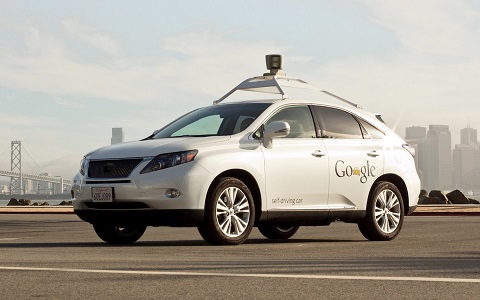Published April 5, 2016, Los Angeles Daily Journal – It is fascinating when you think about it – the day of autonomous cars has finally arrived. Google has jumped to the lead in the race, logging some 1.5 million miles in its fleet of Toyota, Audi and Lexus self-driving cars. But by no stretch is Google alone in this quest. Apple, Ford, Mercedes and some 22 other companies are busy developing autonomous vehicles they hope will take the market by storm.
In many ways, this is a day few historians thought would ever come. Car companies have been talking about the self-driving car for generations, with few successes along the way. General Motors started the conversation in 1939 with its “Futurama” concept car it presented at the New York World Fair. At that time experts predicted automated cars would be commonplace by 1960, forever displacing traditional motoring.
Then at the 1962 Seattle World Fair, GM introduced the Firebird III, a concept car that had an “electronic guide system [that] can rush it over an automatic highway while the driver relaxes.” Experts of the day opined the autonomous car was about “20 years out.”
Much legislative ink has been consumed on the issue as well, as nations also rush to be the first to develop the driverless car. In 1991, Congress enacted the Intermodal Surface Transportation Efficiency Act, which instructed the U.S. Department of Transportation to “demonstrate an automated vehicle and highway system by 1997.” The program was later followed in 1998 by the Transportation Equity Act for the 21st Century, the Safe, Accountable, Flexible, Efficient Transportation Equity Act in 2005, and the Moving Ahead for Progress in the 21st Century Act in 2012. Yet despite the expenditure of billions in public revenue, none of these acts succeeded in achieving the goal of creating an automated highway system set out by GM in 1939 – that is, until now.
With the advent of amazingly-powerful microchips, pinpoint GPS tracking and real-time cloud computing, the autonomous car has migrated from mythical legend to modern day reality. And with it come a host of ethical and legislative issues that are crisscrossing the nation.
Until now, motor vehicles had to be operated by licensed drivers who are required to pass a regimented licensing test to qualify for membership. Anyone who has received a speeding ticket has heard the adage that “a driver’s license is a privilege, not a right.” Now, however, the line is become increasingly blurred in determining who – or what – is allowed to operate a motor vehicle on public roads.
And the conversation is necessary. For all their attributes, autonomous vehicles are not without flaws. On February 14, 2016, one Google car famously crashed when it changed lanes and put itself in the path of an oncoming bus.
This incident is not isolated. According to the University of Michigan Transportation Research Institute, self-driving cars being tested in real-world traffic have a crash rate of more than double that of conventional vehicles. On average, conventional vehicles are involved in 4.1 crashes per one million miles driven. Autonomous vehicles are more than double this, averaging 9.1 crashes per one million miles driven.
One reason for the higher crash rate is that autonomous cars follow the rules of the road to a fault, providing no consideration for real-world driving conditions, such as other motorists who often drive with the flow of traffic, even if it is over the posted speed limit. Having a car that obeys every rule often surprises other drivers, who are expecting more of an ebb and flow in driving patterns.
And then there is the matter of fault, and who exactly is the responsible party for an accident caused by an autonomous vehicle. Is it the registered owner of the car, the person who was in the car, the manufacturer of the car, the service who is providing computing data, or a combination of all? No one seems to have much of an answer.
Currently, there are seven states (California, Nevada, Michigan, Tennessee, North Dakota, Florida and Washington DC) that have enacted legislation regulating autonomous cars. Since 2015, 22 states have introduced legislation to address the issue.
And therein lies part of the problem. As states rush to legislate autonomous cars, our nation will be left with a quilted regulatory framework on what will be required to place an autonomous vehicle on the roadway, and who is responsible for its misgivings. Complicating the issue is the fact that, by their nature, the cars travel, resulting in a potential for conflicting state laws, where, for instance, a car that is domiciled in one state gets into an accident in a neighboring jurisdiction.
Last month, leaders of self-driving car companies testified before the U.S. Senate Committee on Commerce about the need to have Congress regulate the industry to avoid a patchwork of state laws. Testifying were executives of Google, General Motors, auto parts supplier Delphi and ride-sharing service Lyft. As Google executive Chris Urmson stated, “If every state is left to go its own way without a unified approach, operating self-driving cars across state boundaries would be an unworkable situation and one that will significantly hinder safety innovation, interstate commerce, national competitiveness and the eventual deployment of autonomous vehicles.”
With every advancement of technology comes unforeseen setbacks, and frequent strife. Calculators of the 1960s allowed for blistering mathematics, but also created a culture of lazy thinkers. Cell phones gave us enormous freedom, but also brought on texting and driving. The autonomous car will undoubtedly provide societal benefits; just think about all the disabled and elderly people who will now be free to travel. But exactly how it will work itself out is, at this point, still a matter of great debate.
